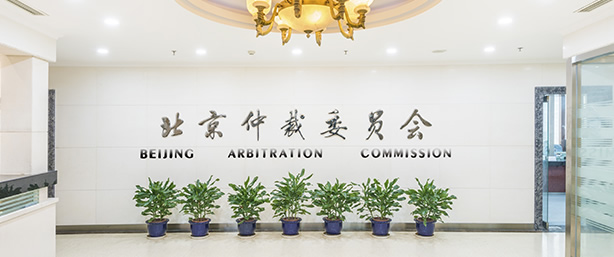
Speech at the Tea Party of 2011 Spring Festival
The work undertaken by the Beijing Arbitration Commission in 2010 can be divided into five aspects:
I. Cases
A Case Volume
(I) During 2010, Beijing Arbitration Commission accepted 1,566 cases in total, a decrease of 264 cases (14.43%) compared with 2009. Of the 1,566 cases accepted in 2010, 1,528 cases were closed, a decrease of 453 cases (22.87%) compared with 2009. The rate of cases closed in 2010 was 97.57%. The following is a comparison of cases accepted and closed in 2009 and 2010:
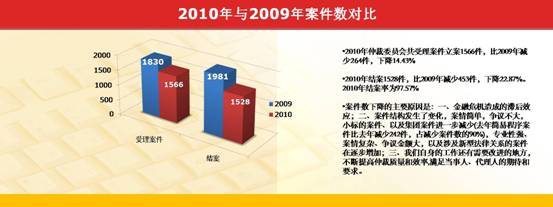
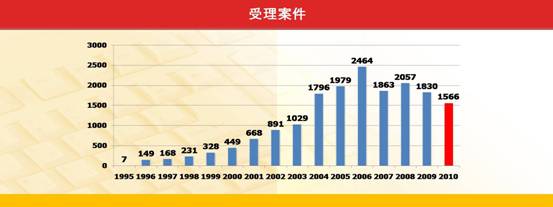
The decrease of cases can be attributed to the following three factors:
Firstly the hysteresis effect of the global financial crisis;
Secondly, the structure of cases has changed C cases with simple circumstances, without large values of claim and with small subjects, in addition to group cases, further decreased in volume Compared with 2009, in 2010 the cases applicable to summary proceedings decreased by 242 cases, accounting for 90% of the total decrease in case volume. By contrast, cases of a complex nature, such as those involving complicated circumstances and requiring a strong need for expertise, large values of claim or new types of legal relationship, increased in volume.
Third, there is room for improved efficiency of the administration of cases, an issue being addressed through the Beijing Arbitration Commissions ongoing review and reform processes. As the expectations of both parties and agents involved in arbitration increase, the Beijing Arbitration Commission must continue to improve the quality and efficiency of arbitration to achieve the result of case closed and dispute settled. Such an endeavour demands the realization of a combination of both legal and social influences. In order to reverse the current decreasing trend of case volume,, we will explore new and strengthen current promotional avenues, develop innovative business growth mechanisms and continue to maintain our business advantages.
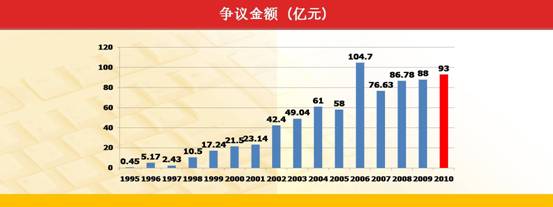
(II) Case Subject
The total case subject in 2010 was RMB 9.3 billion, increasing by RMB 500 million (5.57%) compared with 2009. The average value of claim per case was RMB 5.939 million, increasing by 23.73% since 2009.
(III) Types of Cases
In terms of the cases accepted, the types of cases and the frequency of each type is set out below:
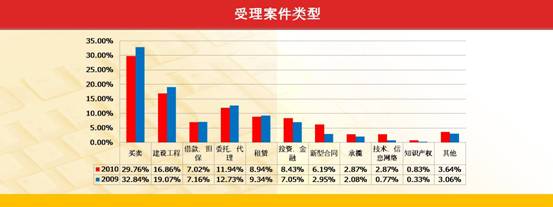
Among the cases accepted in 2010, disputes related to:
sales and purchase contracts accounted for 29.76%;
construction contracts accounted for 16.86%;
commission and agent contracts accounted for 11.94%;
rent contracts accounted for 8.94%;
loans and guarantees contracts accounted for 7.02%;
investments and finance accounted for 8.43%;
new types of contracts were 6.19%;
work of contractors were 2.87%;
information networks were 1.85%;
technology contracts were 1.02%;
intellectual property rights were 0.83%; and other disputes accounted for 3.64%.
Compared with 2009, the following differences were noted in relation to the types of cases received:
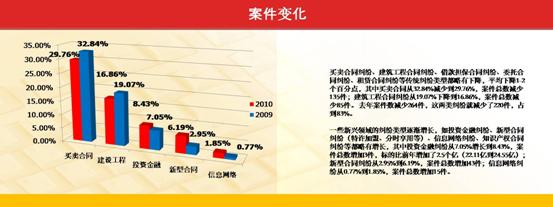
In 2010, the number of cases involving traditional dispute types, such those relating to sales and purchase contracts, construction contracts, loans and guarantees contracts, commission contracts and rent contracts, slightly decreased by 1-2 percentage points on average. Disputes involving sale and purchase contracts decreased from 32.84% to 29.76%, with the total volume of these cases decreasing by 135 cases compared with 2009. Disputes involving construction contracts decreased from 19.07% to 16.86%, with the total number of cases of that type decreasing by 85 cases. The overall cases in 2010 decreased by 264, among which 220 (83%) were related to disputes regarding sale and purchase contracts as well as construction contracts.
It is also noted that the number of cases involving disputes in various emerging areas increased. For example, disputes related to investments and finance, new types of contracts (franchise, timesharing, etc.), information networks and intellectual property rights witnessed a slight increase, among which disputes related to investments and finance increased from 7.05% to 8.43%, with the total number of these type of cases increasing by 3 and the total subject increasing by RMB 250 million (from RMB 2.211 billion to RMB 2.455 billion) compared with 2009. Disputes related to new types of contracts increased from 2.95% to 6.19%, with the total number of cases of the type increasing by 43 cases; while disputes involving information networks increased from 0.77% to 1.85%, with the total number of cases of this type increasing by 15 cases.
(IV) Domestic and Foreign Parties
In 2010, the cases where one or both of the parties involved were located outside Beijing totalled 526, accounting for 34% of the total cases. This was a decrease by 17 cases (3%) compared with 2009. There were 92 cases cases where both parties were located outside Beijing. The changes in case volume are set out as follows:

In 2010, the number of cases involving foreign interests was 32, decreasing by 40 cases (56%) compared with 2009, among which the cases involving parties from Hong Kong, Macao and Taiwan decreased by 34 cases. For details, please refer to the following figures.
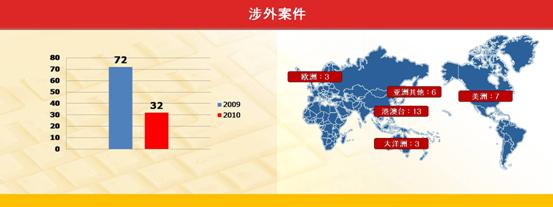
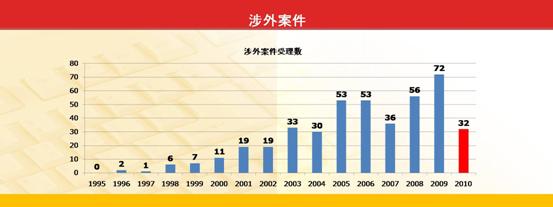
(V) International Cases
In 2010, we successfully mediated two international commercial cases, one of which involved companies in China and abroad and the other involved enterprises in mainland China and Taiwan. Both of the cases comprised highly complicated disputes and involved several related cases. In the case involving companies in China and abroad, the parties involved engaged two mediators from their own countries or regions to carry out co-mediation and achieved success. This kind of co-mediation has broad application and illustrates a useful approach to successfully handling international commercial disputes.
(VI) Co-mediation of Construction Disputes
In addition, we have been discussing with the Beijing Municipal Commission of Housing and Urban-Rural Development methods which could accelerate the handling of construction disputes through co-mediation since October 2010. In January 2011, we accepted a case of labor dispute mediation and opened a court session on 11 January 2011. Although a settlement agreement was not reached, through the determined work of the mediators, the issues were narrowed and an agreement was reached to pursue arbitration through summary proceedings. This outcome proved satisfying to all parties involved, in addition to the leaders of the related offices and departments of Beijing Municipal Commission of Housing and Urban-Rural Development.
This case was significant in that it evidenced the benefits of exploring innovative methods to accelerate the handling of construction disputes and leveraging the role of mediation and arbitration. It also provided a successful example of establishling cooperation between the Beijing Arbitration Commission and related departments to promote new, diversified ways for handling disputes.
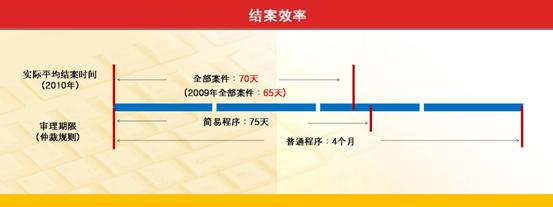
(VII) Case Outcomes
In 2010, the average time from composing an arbitral tribunal to closing the case was 70 days, increasing by 5 days compared with 2009.
Among the cases closed in 2010, 855 were closed through an award, accounting for 56%, which is equal to that in 2009, noting that the total number of cases decreased by 264 cases compared with 2009. Of the cases closed, 260 cases were closed through mediation (decreasing by 12 cases compared with 2009), accounting for 17.02% (increasing by 3.32% compared with 2009). The number of cases withdrawn through settlement between the parties involved was 353 (decreasing by 165 cases compared with 2009), accounting for 23.1% (decreasing by 3% compared with 2009); and the number of cases withdrawn due to other reasons was 56 - accounting for 3.66%. For details, please refer to Figure 13 and 14 below.
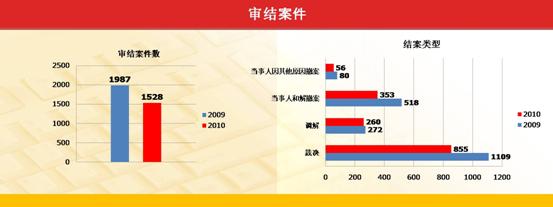
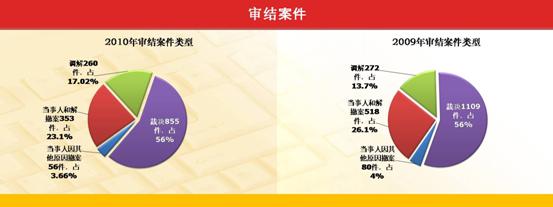
In 2010, there were 9 cases adjudicated to be withdrawn by a Peoples Court, among which 5 cases were withdrawn after re-adjudication. Re-arbitration was applied to 2 cases. Refusal of enforcement was determined in 9 cases, among which 7 cases received refusal of enforcement due to suppression of evidence by the parties involved. The cases withdrawn or under refusal of enforcement or re-adjudication in 2010 increased.
Where the reasons for withdrawal are attributable to the Beijing Arbitration Commission, such reasons will be taken into account in the ongoing reform of Beijing Arbitration Commissionss procedures. Where it is a result of legislation and law enforcement by courts, we will undertake corresponding research, report to the related authorities and propose opinions and suggestions regarding the solutions to endeavor to create a flexible environment that benefits the broader development of arbitration in the country.
By the end of 2010, Beijing Arbitration Commission had, since its inception, accepted in total 17,457 cases, 16,658 cases of which were closed, reaching a case closure rate of 95.42%. According to available data, among the cases closed, those adjudicated by a Peoples court to be withdrawn (including partial withdrawal) and to apply re-arbitration and refusal of enforcement were 60, 22 and 36 cases, respectively, the aggregate of which accounted for 7% of the overall number of cases closed.

II. Performance
(I) In 2010, Beijing Arbitration Commission received an income of RMB 68,066,000 (among which income from arbitration was RMB 63,660,300, and rental income and other income were RMB 4,405,700), and paid taxes of RMB 14,152,200, decreasing RMB 352,900 (2.43%) compared with 2009. The accumulated taxes the Beijing Arbitration Commission has paid totals RMB 98,188,500 which is 22 times of the financial allocation received by the commission at the beginning of its establishment.
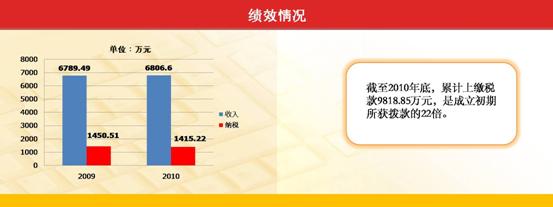
(II) In 2010, Beijing Arbitration Commission had a total of 28 regular employees and 3 supporting staff, including 20 secretaries. The average number of cases closed per person was 76 cases. The finance officers handled nearly 20,000 financial documents, calculated about 1,863 pieces of payments for arbitrators, made online detailed declaration of 2,897 person-times, and issued 272 pieces of tax payment schedules. In addition, they also engaged in work related to promotion, training, theoretical research, meeting organization, international exchange, website development, management software development, etc.

III. Extended tenures of members and arbitrators of Beijing Arbitration Commission and personnel changes
(I) According to Article 6 of 2006 Articles of Association of Beijing Arbitration Commission, each tenure of every member of the commission lasts for 3 years. Under this rule, the current tenure of members of the commission would have ended by 28 September 2010. However, on 1 February 2008, the commission revised and approved the new Articles of Association of Beijing Arbitration Commission, within which the tenure of the members were extended from 3 years to 5 years. This extension was made in consideration of the fact that following four elections, the governance structure, in addition to the guidelines and policies of the commission, had become more sophisticated and therefore it was not necessary to maintain a short tenure. This allowed us to increase efficicieny and avoid time wasting due to frequent elections. Therefore, the directors of the commission, after reporting to and receiving approval from Beijing Municipal Government, amended the current tenure of members, allowing them to be automatically extended pursuant to the new articles of association for 2 more years to 28 September 2012.
(II) Since Wu Derui, member of the current commission, was retired, upon consultation of Beijing Arbitration Commission with Beijing Sub-council of China Council for the Promotion of International Trade (CCPIT), and after reporting to and receiving approval from Beijing Municipal Government, we decided to appoint Zhang Gang, Vice President of CCPIT, to replace Wu Derui as a member of the commission.
Professor Zhang Chunlin, member of the current commission, requested to withdraw from the commission due to a change in employment. Following consultation with Peking University and other related departments, and after reporting to and receiving approval from Beijing Municipal Government, we decided to engage Professor Zhou Qiren who serves China Center for Economic Research of Peking University to be the member of the commission.
Following from the personnel changes, the members of the current commission include: Jiang Ping, Director; Zhou Jidong, Deputy Director; Wu Zhipan, Deputy Director; Li Yanping, Deputy Director; Wang Liming, Deputy Director; and 10 members: Wang Hongsong, Dong Chunjiang, Liang Huixing, Che Pizhao, Zhang Gang, Ma Yuping, Zhou Qiren, Zhu Jiang, Zhang Weiying and Zhou Tianyong.
(III) In 2010, in order to make the term of employment of arbitrators consistent with the 5-year tenure of members of the fifth commission (as reflected in the revised articles of association), we employed new arbitrators, extended the term of employment of current arbitrators and made adjustments to the arbitrator team. Twenty-seven arbitrators were newly employed, and 54 arbitrators did not receive their employment extension due to age or other reasons.
Following the election, the commission currently employs 370 arbitrators in total, among which 299 are domestic arbitrators and 71 are foreign arbitrators. Among the current arbitrators, 139 of them hold a PhD Degree, accounting for 37.6%, which increased 1 percentage point compared with the last commission; 136 of them hold a Master Degree, accounting for 36.7%, equal to that of the last commission; and 95 of them hold a Bachelor Degree, accounting for 25.7%, which decreased by 1 percentage point compared with the last commission.
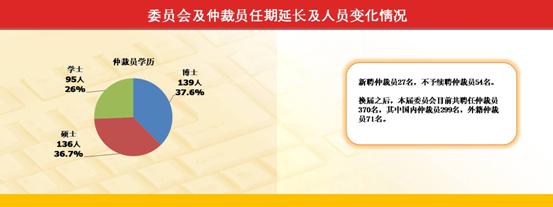
V. International communication and exchange
(I) In 2010, Beijing Arbitration Commission attended international and regional meetings and organized five international visits, including:
1. On March 15, we went to Milan upon invitation to attend a special seminar about the arbitration of China and presented a keynote speech. On March 19, we headed to the University of Cambridge upon invitation to attend the International Dispute Resolution Conference and made a keynote speech entitled Experiences of China in Institutional Arbitration which was published in the Construction Law Journal in UK. During that period, we visited 3 dispute resolution institutions, 2 law schools and 8 international law firms in the UK and Italy to facilitate cooperation between the commission and the law societies of those countries.
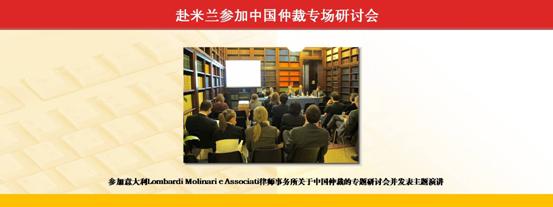
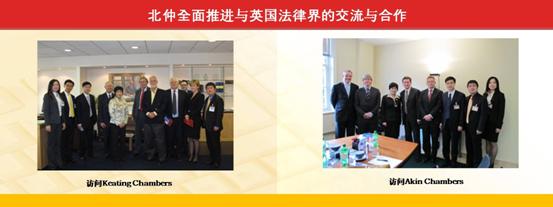
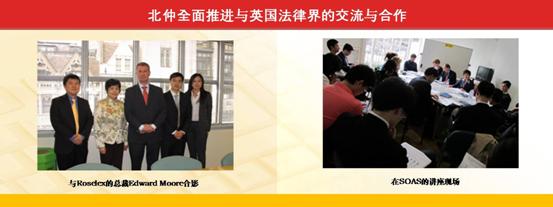
2. In June, we attended the Preferred Firm Litigation Conference organized by Berwin Leighton Paisner (BLP) LLP in London, and presented a keynote speech entitled East or West- where to arbitrate together with James Clanchy, Deputy Director General, London Court of International Arbitration. Through this event, we further established contacts with several international law firms.

IIIn 2010, we focused on reinforcing domestic promotion. Based on the advanced facilities of the commission, we worked jointly with domestic and overseas colleges and universities, law firms, commerce associations and enterprises to hold more than 20 special seminars, arranged visits to the commission for foreign governments, students and tutors of foreign colleges and universities, foreign dispute resolution institutions and foreign law firms, and carried out more than 60 academic exchange activities attended by over 3,000 participants. Both the number of meetings and the number of participants witnessed a significant increase compared with those of 2009. Such activities included:

1. In 2010, we jointly hosted, with the Chartered Institute of Building, UK, the CIOB Learning Center of Tsinghua University, the Design-Build Guild and the International Engineering Management School of Tianjin University, the 15th Joint Construction Management Talks. The speakers were all domestically and internationally recognized experts and scholars in the areas of construction law and construction management, and the talks focused on the hotspots and difficulties in current construction management practice. Two case management meetings were held, with more than 200 participants present and over 100 people attending through the online visual platform provided by the commission. Since its inception, more than 1,000 participants coming from the majority of large construction enterprises and from a large number of law firms have attended the Talks. The Joint Construction Management Talks have provoked a wide interest from the construction industry and the legal industry.
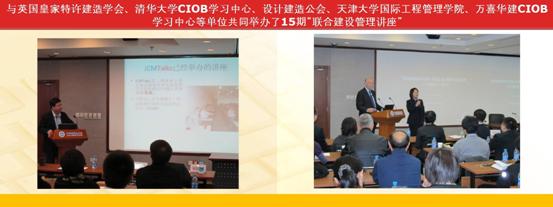
2. On March 6, we worked jointly with the Securities Law Research Institute of China Law Society, the Law School of the Central University of Finance and Economics, China and the Legal Daily to hold a special seminar discussing the important legal issues related to protection of investors in capital markets. It is the second financial meeting attended by the representatives of the National Peoples Congress (NPC) and the Chinese Peoples Political Consultative Conference (CPPCC). By jointly hosting these two conferences, the Beijing Arbitration Commission has played an active role in facilitating the promotion and development of Rule of Law in the securities area.
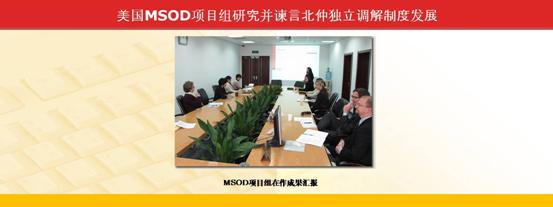
3. From March 29 to March 31, the MSOD (Master of Science of Organization Development) project of the Graziadio School of Business and Management, Pepperdine University, visited the Beijing Arbitration Commission for study and observation for the 5th time in the past 5 consecutive years. The independent mediation system of the commission has become a study topic of the MSOD project team. The team also proposed suggestions regarding the development of the commissions mediation business based on its comparative studies on the mediation institutions in the USA.
4. On April 15, we worked jointly with Beijing Lawyers Association to hold a Special Seminar regarding Appraisal of Construction Cost in Dispute Cases concerning Construction Charges. The senior judges from the related chambers of Beijing No. 1 Intermediate People Court and Beijing No. 2 Intermediate People Court, the senior arbitrators in the construction areas from Beijing Arbitration Commission and the experienced lawyers from the Construction Committee of Beijing Lawyers Association exchanged ideas and discussed their opinions on the appraisal of construction costs in cases concerning construction charges.
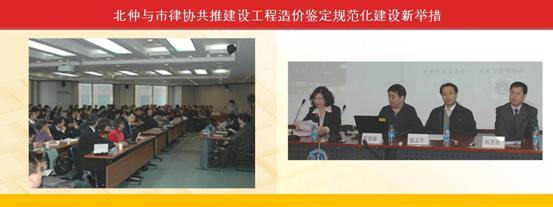
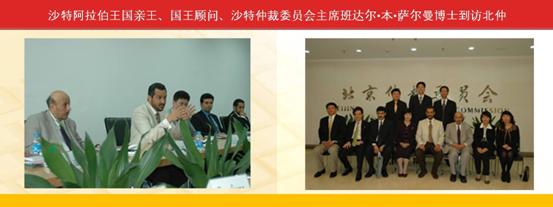
5. On May 18, Dr. Bandar bin Sultan, Prince of the Kingdom of Saudi Arabia, Adviser of the King and Chairman of the Arbitration Commission of Saudi Arabia, accompanied by the Saudi Arabian Ambassador to China and his entourage, visited Beijing Arbitration Commission. We introduced the characteristics of the arbitration system of China and the development of the commission, especially the measures adopted by the commission to safeguard its independence as well as justness and professionalism of its arbitrators to Prince Sultan and the accompanying group. Prince Sultan is the highest-rank foreign head who has ever visited Beijing Arbitration Commission, which indicates that the commission has become a window to display the achievements of the legal reform in China and is playing a more active role in facilitating foreign exchange.
6. On May 21 and 27, 2010, the Awarding Ceremony for the 7th New Academic Talent Essay Contest and China Law Summit with China University of Political Science and Law and Beijing Arbitration Commission as its chief organizer and co-organizer, respectively, was successfully held in the university. Jiang Ping, Director of Beijing Arbitration Commission and I attended the awarding ceremony upon invitation. The commission always pays close attention to and supports the important teaching and scientific research activities carried out by the colleges and universities of China. The New Academic Talent Essay Contest and China Law Summit held each year by China University of Political Science and Law continues to be a well organized event with strong credibility, and as such the Beijing Arbitration Commission remains a proud sponsor since 2008.
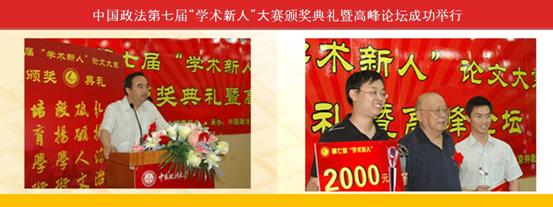
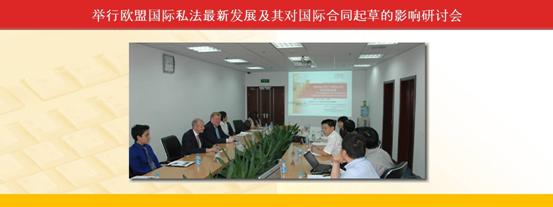
7. On June 29, the Beijing Arbitration Commission and Chinese European Arbitration Center jointly held the Seminar for the Latest Development of International Private Law of EU and its Influence on Drafting of International Contracts. Arbitrators of the commission and other professionals attended the seminar, and engaged in dynamic discussions with representatives from the Chinese European Arbitration Center regarding relevant provisions of the international private law of China, the identification and attitudes of Chinese courts to foreign awards, and a comparison between the arbitration institutions of China and Germany.
8. On September 16, the Beijing Arbitration Commission and the Network of Legal Counsels in the Legal Departments of Multinational Companies in Beijing jointly organized an autumn dinner party with the theme Current Situation and Improvement of the Legal Risk Management Mechanisms Adopted by Chinas Group Companies .
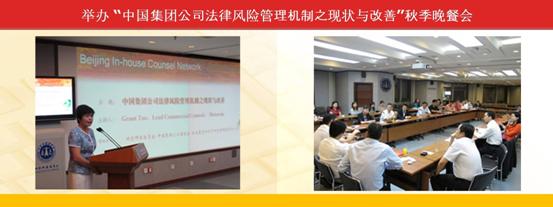
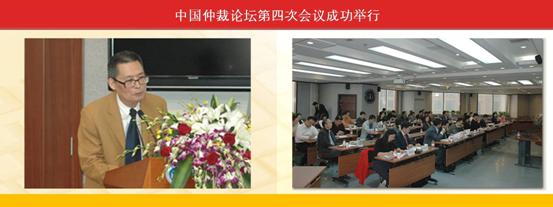
9. On October 9, to commemorate the 15th anniversary of the implementation of the Arbitration Law of China, we worked with the Law School of Tsinghua University to jointly organize the 4th Conference of China Arbitration Forum. Two topics of the conference were Fiscal and Tax Issues of Arbitration Institutions under the System of Self-responsible Income Earning and Expense Allocation and Issues regarding Management System and Code of Conduct of Arbitrators. Representatives of more than 20 domestic arbitration institutions, including the Chinese International Economic and Trade Arbitration Commission (CIETAC), Shanghai Arbitration Commission and Guangzhou Arbitration Commission, in addition to experts and scholars from Tsinghua University, Peking University, China Foreign Affairs University, and Wuhan University attended the conference. Professor Liang Huixing, Chairman of China Arbitration Forum, presented a speech. The participants engaged in discussions about the current reform of the arbitration system and the moral education of arbitrators. Some essays presented in the conference were published in Arbitration in Beijing and provoked strong interests and responses within the industry.
10. On November 23, we worked together with CIETAC and the Editorial Board of China Construction Law Review to jointly hold the China Construction Dispute Review Forum, which was attended by more than 200 participants including domestic and overseas legal experts, legal counsels of construction enterprises and lawyers. The Law Press of China, Chinalawinfo.com, LexisNexis, Thomson Reuters, Peoples Court Daily and China-arbitration.com made full track reports on the conference.
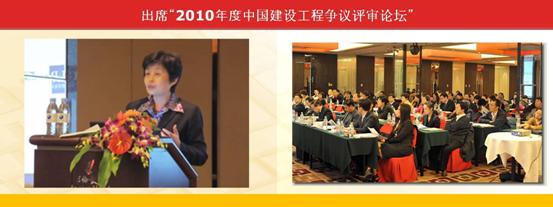
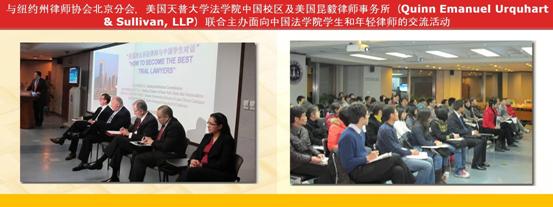
11. On December 6, we, together with Beijing Sub-association of New York State Bar Association of US, Chinese School of the Law School of Temple University, US and Quinn Emanuel Urquhart & Sullivan, LLP, held an exchange activity for students from law schools of China and young lawyers. More than 70 students from top nationwide law schools including Tsinghua University, Peking University, Renmin University of China, China University of Political Science and Law participated in the activity.
12. In 2010, we also had symposiums with many delegations who visited Beijing Arbitration Commission, including the learning and observation delegation of Hong Kong judiciary, the visiting delegation of Taiwan arbitrators, the visiting delegation of students of the Law School, Pepperdine University, US, the visiting delegation of MBA students of the Northeastern University, US, the learning and observation delegation of Spanish lawyers and the LLM students of Chinese Laws of the Law School, Tsinghua University; arranged visits to and observations of the commission for government authorities, chambers of commerce, dispute resolution institutions, law firms of Russia, US, UK and Italy. Additionally, Beijing Arbitration Commission accepted 13 PhD students and postgraduate students of the law schools of Harvard University, Yale University, University of California at Berkeley, University of California at Hastings, Pepperdine University, Wisconsin University and Boston University of US, University of London and University of Warwick of UK, University of Sydney and Deakin University of Australia to have their internship in Beijing Arbitration Commission. By now, Beijing Arbitration Commission has accepted in total approximately 40 overseas students from US, UK, Australia, Russia, Moldova and other countries to have their internship here, which has played a positive role in promoting the Chinese arbitration system in addition to Chinas ongoing reform.
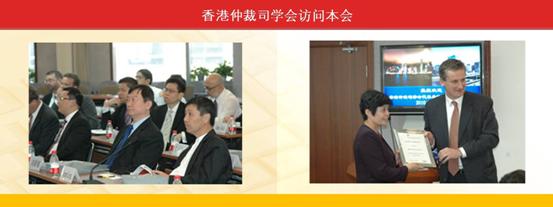


13. Also in 2010, we were invited to provide training on topics such as code of conduct of arbitrators and arbitration proceedings for the arbitration commissions in Xin Xiang, Yun Cheng and Jin Cheng. Additionally, we delivered a lecture on arbitration practices, in the Training for Chief Legal Counsels of Enterprises held by the University of International Business and Economics, Shanghai Sub-chamber of the European Union Chamber of Commerce in China, China Telecom and State-owned Assets Supervision and Administration Commission of Peoples Government of Beijing Municipality. More than 1,000 participants attended the training.
(III) In 2010, seven articles regarding Beijing Arbitration Commission and the diversified dispute resolution mechanism were published in domestic journals and magazines; 4 issues (No. 71-74) of Arbitration in Beijing containing 45 articles of 519,000 words in total were edited and published; 2 issues of Beijing Arbitration Commission Newsletter containing more than 30,000 Chinese words and 13,000 English words were edited and published. Meanwhile, based on actual needs, the form of bimonthly journals will be applied in 2011. Features in publications such as the compilation A Course in Legal Papers, World Arbitration Reporter, Chinas Arbitration Handbook, etc., all of which included detailed introduction about the development, arbitration resources and arbitration rules of Beijing Arbitration Commission, promoted the commission to domestic and overseas readers. In the same year, my personal corpus Casting Credibility was published. The corpus made a systematic arrangement of the contents regarding the development path, system changes and cultivation of corporate cultures of the commission.
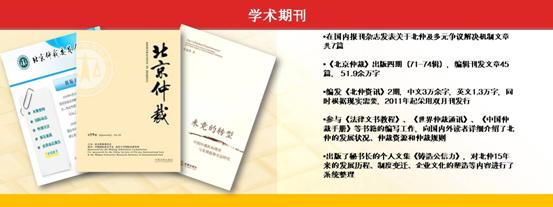
In 2010, we optimized the code and key words of our website in five languages, carried out appropriate compilation and arrangement of website contents and revised some pages of the website so that all the large search engines can more easily search for information related to the commission, visitors can find and read our information more conveniently and we can therefore increase awareness of the commission. Also in the same year, 136 pieces of featured news with 390 pictures were edited and published. On the English website, 23 pieces of news were posted and concurrent publication of news in Chinese and English regarding foreign affairs were released. The traffic of the website reached 505,867 hits, increasing by 13.3% compared with 2009, in particular, the website in Chinese had an increase of 13.3%, the website in English had an increase of 12.5%, the website in Japanese has an increase of 9.7%, the website in Korean witnessed an increase of 11.8% and the website in French witnessed an increase of 18.5%. For details, please refer to the following table:
Language |
2009hits |
2010hits |
Rate of increase |
Chinese |
294564 |
331524 |
13.3% |
English |
59778 |
70195 |
12.5% |
Korean |
28734 |
32134 |
11.8% |
Japanese |
36700 |
40267 |
9.7% |
French |
26789 |
31747 |
18.5% |
Total |
446565 |
505867 |
13.3% |
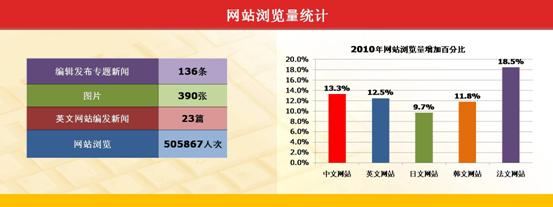
V. Training and theoretical research
(I) In terms of training, we continue to explore and improve the contents and methods used in arbitrator training and arbitration training for new lawyers, and leverage the platform and resources of Beijing Arbitration Commission to combine and complement training with promotion to achieve co-development of these two goals.
1. In July 2010, we assisted the Law School of Tsinghua University to hold the 10th Arbitrator Training. Forty-nine practitioners attended the training and assessment, 48 of them passed the assessment and 15 of them were employed by the commission as arbitrators in 2010. By now ten sessions of training have been held and 505 people have been trained in total. Of those trained, there are 128 arbitrators currently in office and a further 383 practitioners who have attended the training. Among the 383 practitioners, 126 of them have been employed as arbitrators. Since the implementation of the Decision of Beijing Arbitration Commission on Strengthening Arbitrator Training and Assessment in August 2004, among the newly employed arbitrators, 99% of them have undertaken the training and passed the assessment. The training not only increases professionalism of arbitrators, but also enhances the value, culture and philosophy of the Beijing Arbitration Commission.
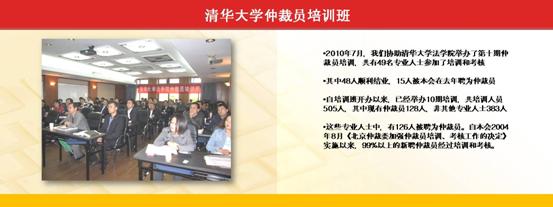

2. In 2010 we worked together with Beijing Lawyers Association and the Continuous Education College of China University of Political Science and Law to carry out 8 sessions of Training for New Lawyers through the format of simulating an arbitral tribunal. Thirty-two arbitrators gave their lectures and more than 1,200 new lawyers attended the training. Since October 2009, when the Training for New Lawyers commenced, to 7 January 2011, 11 sessions of training have been arranged, with an aggregate of 44 volunteer arbitrators giving lectures and more than 1,700 new lawyers participating in the training. After over a year of implementation, the Training for New Lawyers has become a featured project in the education cooperation among the commission, Beijing Lawyers Association and the Continuous Education College of China University of Political Science and Law
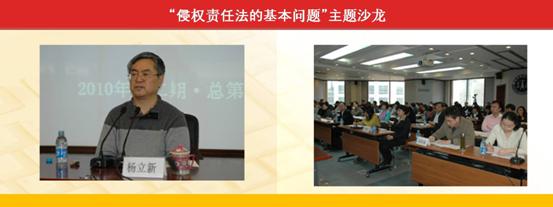
3. In 2010, we held in total 13 sessions of Arbitrator Salon, including: discussion on legal issues in the construction industry, basic issues in the Tort Law of China, exchange of arbitration practices, analysis on several disputes in the application of the Company Law of China, remedies and enforcement of international commercial arbitration, experiences and techniques with respect to mediation of commercial disputes, techniques related to judgment, verification and hearing, techniques of mediation, laws and practices of Singapore International Arbitration Center, interest conflicts and disclosure obligations in international arbitration, financial derivatives transactions C related legal supervision issues and practice cases, practices of international commerce arbitration, emerging risks of overseas investments, etc. Meanwhile, the Experts Group of the Arbitrator Salon held 3 activities. In total, more than 1,100 arbitrators and other practitioners attended the above activities.
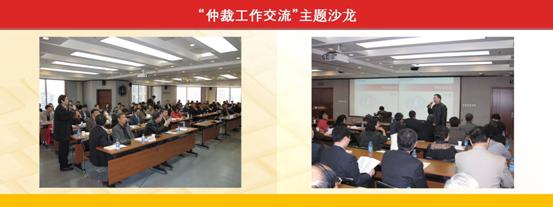
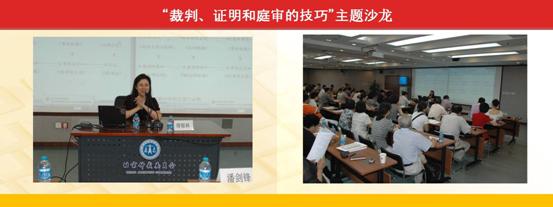
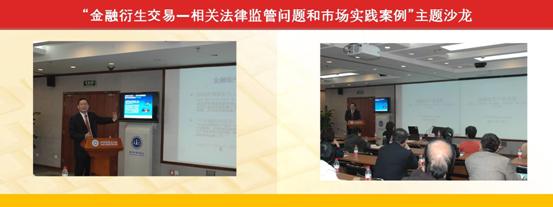
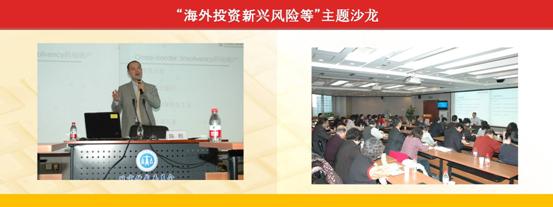
4. In 2010, Beijing Arbitration Commission assisted the Law School of Peking University to open a course of contract law practices and appointed 8 arbitrators as lecturers. The course benefited from the contributions of legal professionals specializing in different areas, who provided different ideas and theories, and coupled theory and practical experience together, with highly positive feedback from participating students. It was not only a breakthrough for the commission in the areas of arbitration training and promotion, but also reflected its deep engagement in and support for the current reform of legal education.
(II) The research in 2010 mainly focused on several aspects, including prevention of enterprise risks, judicial review of arbitration and improvement of award quality, amongst others.
1. At the beginning of 2010, we participated in the task force Legal Risk Management Mechanism for Group Companies led by China Group Companies Association, undertook the sub-task project related to research in dispute resolution of group companies, drafted the investigation and research outline, and participated in the investigation and research activities of the task force in Sinochem, Genertec, Lenovo, Datang, Baosteel, and Wanxiang. In addition, we also undertook three task force meetings attended by legal counsels of enterprises directly controlled by the central government of China, and cooperated with China Group Companies Association to launch a large-scale activity soliciting essays on prevention of legal risks. At present, we are finishing the related investigation and research reports. These activities have drawn wide attention from the legal departments of enterprises directly controlled by the central government of China.
2. On May 11, 13 and 18 of 2010, we invited arbitrators from different fields to attend symposiums related to increasing award quality and efficiency, and carried out methods of improvement from the following 5 aspects based on the opinions of those arbitrators:
First, our office developed specific rectification measures based on the aspects proposed by the arbitrators regarding the court records, communication skills and efficiency of handling cases by secretaries that need to be improved, and uploaded the measures to the online arbitrator office.
Second, in order to make arbitrators promptly know about the awards adjudicated by courts to be withdrawn or under refusal of enforcement, we uploaded in a timely manner the adjudication of courts regarding award withdrawal and refusal of enforcement as well as the related awards to the online office.
Third, we encouraged the arbitrators through the Development Committee to participate in the development of the guiding opinions of case classification. In 2010, the Development Committee organized special task forces in respect of guiding opinions on handling cases involving disputes related to construction, shares and securities, real estate sales, purchase and rent as well as finance, analysis and research on the adjudication of courts on award withdrawal and refusal of enforcement, and the Training for New Lawyers. Currently, 4 task forces have made staged achievements, including drafts for discussion of guiding opinions on handling three types of cases involving construction, nominated shares and transfer of equities, and finance, and an analysis report for the adjudication of courts on refusal of enforcement made since the establishment of the commission. We intend to load those achievements to the online office for learning and discussion.
Fourth, we started to summarize the past awards related to the construction area. By now, we have sorted 60 legal questions and 120 cases in a total of 300,000 words.
Fifth, in terms of some new issues in property preservation in arbitration and enforcement of arbitration awards, we have carried out active communication with the Enforcement Chamber of Beijing High Peoples Court and the Preservation Unit of the Case Filing Chamber of Beijing No.1 Intermediate Peoples Court and exchanged opinions to gain their understanding and support of our arbitration work.
In the future, we will continue with such efforts.
VI. Software development and office construction
(I) During 2010, we continued to improve our case handling management system and arbitrator online office system. We developed EMS printing and management system to directly retrieve names and addresses of the parties involved and agents from the system and link to the EMS website to track mail delivery. Upon receipt of EMS signoff receipt, the front desk would scan the receipt and the system would make automatic recognition and match it with the delivery record. In the arbitrator online office system, we added the function of term reminding to show the length of the remaining term within which an arbitration award should be rendered with different colors for arbitrators to easily recognize their timeline. In addition, we also added the function of mutual reminding between secretaries and arbitrators: upon completion of the trial, a secretary would add the date of making an award which would be sent regularly to the arbitral tribunal to remind it of rendering a timely award until the award is made. After that, the arbitrator would remind the secretary of the delivery of the award. The function of arbitrator payroll summary was also developed for arbitrators to check against their records.
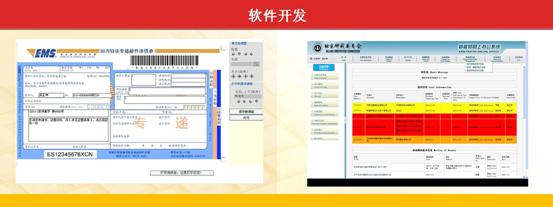
In terms of hardware, new uninterruptible power system and firewall system were purchased to safeguard the security and stability of our office facilities and network, and VPN remote operation was achieved. The LCD information display system was also in place to facilitate the distribution of information related to meetings and court sessions. Moreover, the light bulbs of projectors were replaced to improve projection clarity.
(II) During 2010, eight employees left and 4 new employees filled in. Despite the reduced work force and change of personnel, all the staff cooperated and collaborated with each other to ensure smooth progress of each task.
(III) In order to further improve the management system of the commission and carry out the performance evaluation system applicable to the middle-level management, we made performance evaluation of two division chief in 2010. Meanwhile, for the long-term development of the commission, 3 division chief and 3 deputy division chief (their names, division of work, responsibilities and contact information were published on the website) were appointed through open competition and democratic election. As a result, a middle-level management team with young, vigorous, innovative, enthusiastic and energetic members was established. I believe that they will be able to create, with the joint efforts of others, a safe and reliable future full of hope for Beijing Arbitration Commission after several years of practice and experience.
Above-mentioned information comprises the 2010 work report. Every achievement mentioned in the report was made based on your great efforts. Our every progress was achieved through your encouragement, support and confidence. Although no single word can express our gratitude and appreciation, I would like to take this opportunity to present, on behalf of all the office staff, our sincere appreciation to all the members and arbitrators of the commission, all the leaders and all the friends!
VII Reflections and Future Vision of Beijing Arbitration Commissions Progress
Beijing Arbitration Commission has been set up for 15 years. In 2002, we mustered up our courage to set the goal of developing the commission to be an arbitration institution which would have importance and influence within the international arbitration community.. Nine years have passed. Although we cannot say the goal has been achieved, much progress has been made. Not only do we have an outstanding arbitrator and personnel team, strong professional capabilities, advanced facilities, sound reputation, wide influence, rich experience, but also a broad vision, illustrated by ongoing international engagement and exchanges, and a strong and genuine pursuit of innovation to achieve independence and efficiency.
Our next goal is to develop Beijing Arbitration Commission into not only a worldwide first-class arbitration institution, but also a diversified dispute resolution center integrating services of arbitration, resolution and review of construction projects. Moreover, we wish to provide a center of information exchange, research and training, publicity and promotion related to diversified dispute resolution measures to become an important force facilitating diversified dispute resolution development in China.. With superior resources and conditions setting Beijing Arbitration Commission apart, greater responsibility is assumed to ensure significant achievements and contributions continue. The future of Beijing Arbitration Commission is closely connected with the reform of Chinas arbitration system and development of the diversified dispute resolution system. Development is the only way through which we are able to have more opportunities and better prospects. Lets work together to create the history, the future and the new record.